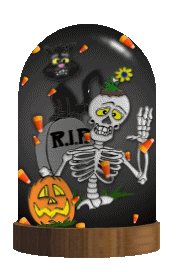




Halloween,
which takes it's name from the medieval 'All Hallows
Eve', takes place on October 31st, and was originally the
Celtic pagan festival of Samhain (pronounced Sow-en). The
Catholic church adopted the original pagan festival and
Christianised it, making the following day November 1st,
'All Hallows Day' or 'All Saint's Day', and November 2nd,
'Hallow Tide' or 'All Soul's Day'.
Samhain was
the Celtic pagan's New Year, and officially the end of
Summer. It marked the begining of Winter which
symbolically represented death. They believed that it was
the time of year when the veil between our world and the
next was the thinnest and the dead may pass to and fro
through the veils. It was the time to honor the ancestors.
For pagan and
Christian alike, this was and still is, a time of
remembering and reverence for those who came before us.


The tradition of going
from house to house wassailing, (caroling in exchange for
a reward at each door) was associated with all the major
Celtic festivals, so it is no surprise to find it
happening at Samahin also.
Whether or not the
early Christian church took the existing practice as
their own is not clear, but certainly by the 9th century,
the custom of 'Souling' was established.
On November 2, All Souls Day, early Christians would walk
from village to village begging for 'Soul Cakes', which
were a kind of oat cake. The more soul cakes the beggars
would receive, the more prayers they would promise to say
on behalf of the dead relatives of the donors. It was
believed that the dead remained in purgatory for a time
after death, and that prayer, even by strangers, could
expedite a soul's passage to heaven.
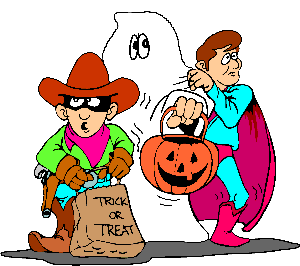 |
Often
'Mummers' or 'Guisers' went around at Halloween.
These were people dressed in costumes who acted
out small plays, and sung songs outside houses in
return for rewards. In many areas, the Guisers
would play pranks on people and in some places,
Halloween became known as 'Mischief Night'. When the Irish immigrants came to
America, they took their Halloween festivities
with them, Guising becoming the tradition of
fancy dress to represent ghosts, goblins and
witches, and mischief making and house to house
calls combing in the custom of 'Trick or Treat'.
|


The traditional
illumination for Guisers or pranksters out on Halloween
was turnips or mangel wurzels, hollowed out to act as
lanterns and often carved with grotesque faces to
represent spirits or goblins.
In eastern England these became
known as Jack o' Lanterns, which was another name
for balls of ignited marsh gas.
But when the
Irish immigrants came to America, they found that
pumpkins were far more plentiful than turnips. So
the Jack o'Lantern in America was a hollowed out
pumpkin, lit with an ember or candle. Gradually
over time, pumpkins have taken over from turnips.
|
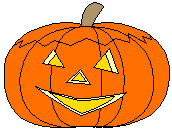
|
Pumpkin facts
A pumpkin
is really a squash, and comes from the same family as the
cucumber.
You can
grow pumpkins all over the world - except in Antarctica!
If your
pumpkin lantern shrivels up, you can restore it by
soaking it overnight in water to rehydrate it.


Why are apples
associated with Halloween? When the Romans conquered
Britain, they brought with them their November 1st
festival honouring Pomona, goddess of fruiting trees.
This accorded with existing Celtic ideas about the apple.
It was said that Avalon, (the Western land where spirits
of the dead dwelled) was distinguished by an abundance of
apple trees bearing fruit year round.
As the veil is thin at Halloween,
this was also an ideal time to foretell the
future. Here are some methods using apples.
It was
believed that the first person to get a bite out
of an apple bobbing in a pail of water, or
suspended on a string would marry in the coming
year.
Peeling an
apple in front of a candle-lit mirror was
believed to produce the image of one's future
spouse.
Attempting to
produce a long unbroken apple peel was said to
estimate the number of years you had to live. The
longer the peel, the longer your life expectancy.
Carefully peel
an apple, making sure that the peel remains in
one long, thin strip. Throw it over your left
shoulder, and if it labds in one piece it will
reveal the initial of your true love.
|
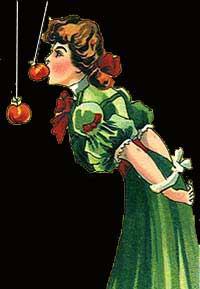
|
Even
today, children recite the alphabet as they twist the
stem from an apple to discover the first letter of their
true love's name.


The
Devil

|
Where ever we meet the Devil in
legend and folklore we are usually in the
presence of an old god. The early Christians
thought the old horned pagan God Cernunnos was
such a threat to their new religion, that they re
named him as The Devil or Satan. The Devil also
has close associations with Standing Stones.
|
'The
Devil's Boulder' is a Standing Stone at Shebbear in South
Devon, England. Unless this great stone is turned every
year on November 5th, disaster will befall the community,
so the ritual is performed with considerable ceremony by
men with crowbars. Prior to the operation the church
bells have to be rung. The Boulder stands at the foot of
an oak tree near the church and was probably a sacred
site before the church was built. Why November 5th? A lot
of pagan Samhain customs were moved to November 5th under
the guise of commemorating Guy Fawkes. Read more under
'Bonfire Night' below.
Bats
A bat flying three times round a
house is said to be a sure sign of the death of
one of the inhabitants.
When bats rise
heavenwards in their flight and then drop swiftly
again, it is said to denote that the witching
hour has come, and all charms and spells will
work especially well at such a time.
It is a sign
of extraordinary good luck if a bat touches you
in its flight.
|
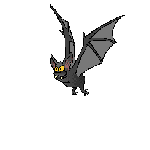 |
Cats

|
Much of the
ill treatment given to cats in past centuries was
due to the belief that they were really witches
in disguise. Until quite recently some people
were very careful about what they said when a cat
was present, in case the animal turned back into
human shape and repeated what it had heard. Cats are said the have psychic
powers and a foreknowledge of approaching
disasters. If a cat deserts a house where a
person is lying sick, that person will shortly
die.
It's said to be very lucky
if a black cat crosses your path.
|
Spiders
Although a lot of people don't like
spiders, spiders are infact very lucky. So always
remember the rhyme ' If you want to live and
thrive, let the spider stay alive'.
Spiders are
weather prophets. If they are industrious in
their web building, that means fine weather. When
stormy weather is about, they do not extend their
webs but hurry to strengthen them.
|
 |
Love Divination
As the veil
is thinnest at Halloweeen, this is considered to also be
a good time to discover if your lover is faithful or not,
and if you will ever marry. As well as the apple methods
described above, there are many other methods. Here are a
few of them.
If you wish
to know whether you and your present beloved will marry,
take two acorns, naming them under a full moon for
yourself and your lover, and drop them into a bowl of
water. If they float together, you will be sure to marry;
but if they float away from one another, that is a token
which speaks of severance.
Put a sprig
of the herb Rosemary and a silver sixpence under your
pillow on All Hallows' Eve and you will dream of your
future spouse.
Each of a
couple throws a nut into the fire.If the nuts explode,
there is great love between them. If they merely whimper,
love is dying. If one nut explodes while the other
sizzles, you may draw your own conclusions.


Remember, remember
the fifth of November,
Gunpowder Treason and Plot,
Pray tell me the reason why Gunpowder treason,
Should ever be forgot.
The Gunpowder Plot was discovered on
November 5th 1605. Guy Fawkes long with several
other conspirators was found to have placed a
large number of barrels filled with gunpowder
under the Houses of Parliment, London, England
with the intention of blowing up the building
along with the King of England, and all the
politicians on the annual State Opening of
Parliment.
Guy Fawkes and
the other conspirators were executed, and ever
since, it has become the custom to light bonfires
on November 5th, burn effigies of Guy Fawkes, and
to set off fireworks in celebration of this
failed attempt at assassination.
|
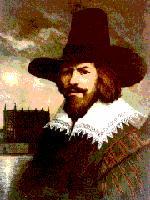
Guy Fawkes
|
A lot
of the festivities surrounding the November 5th
celebrations are very similar to those that used to take
place at Samhain and it is thought that people just moved
their exisiting Samhain festivities to the later date so
that they could continue with them without offending the
church leaders.
Ottery
St Mary
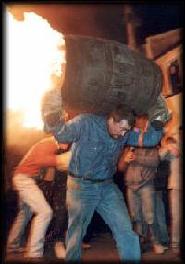
|
Ottery St. Mary in Devon England, is
internationally known for its annual Tar Barrels
festival held each year on November 5th. Opinion
differs as to the origin of this festival of
fire, but the most widely accepted version is
that it began as a pagan ritual that cleansed the
streets of evil spirits.
Each
of Ottery's central public houses sponsors a
single barrel. In the weeks prior to the day of
the event, November 5th, the barrels are soaked
with tar.
Before
dawn, on November 5th, the local people come out
into the streets and fire 'cannon' which are hand-held
pieces of piping that are filled with gunpowder
and fired in the traditional way, to create an
almighty flash and a loud bang. This is repeated
at 1pm and again at 4pm.
|
The barrels themselves are lit outside each
of the pubs in turn and once the flames begin to pour
out, they are hoisted up onto local people's backs and
shoulders. The barrel rollers protect their hands with
dampened sacking and they run back and forth with the
barrel until they can no longer stand the heat and then
they pass it to the next person in line. The more
experienced bearers achieve this by whirling the barrel
around their heads until their successor is ready to
accept it.
In the afternoon and early evening there are women's and
boy's barrels, but as the evening progresses the barrels
get larger and by midnight they weigh at least 30 kilos.
In most cases, generations of the same family carry the
barrels and take great pride in doing so.
Thousands of
people come into Ottery to witness this festival and the
streets around the pubs are packed with people, all eager
to feel the lick of the barrels flame. For those who lose
their nerve or simply want to take a break from the main
spectacle, there is a vast bonfire with a traditional Guy
on it down by the water. Across the river from the
bonfire are the bright lights of the travelling funfair,
with all kinds of stalls and rides. The thousands of
visitors are catered for by mobile vans selling
everything from candy floss to hog roast and the pubs are
open all night, The most highly prized souvenir of the
evening is one of the metal rings from the burnt out
barrels.


Each Autumn
from early September to mid November, thousands
of carnival lovers flock to Somerset, England to
see the now world famous Somerset Illuminated
Carnivals.
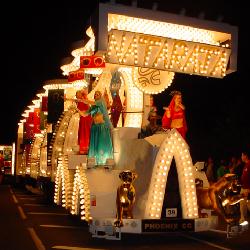
|
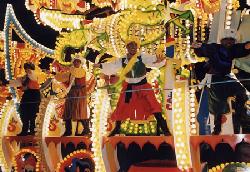
These
take place in 16 towns throughout Somerset and
entries vary from the single masquerader to
the overwhelming 100 ft long floats known locally
as carts in the Bridgewater area, as
originally they were farm carts. These
masterpieces are all created by amateurs,
who belong to one of the many Somerset
carnival clubs. The huge illuminated floats are
usually around 100 ft long 11 ft wide and 17.5
ft high and are illuminated by anything up to 32,000
light bulbs, each entry pulling its mobile
generating plant of anything up to 1.2 mega watts.
|
There
are also similar illuminated carnivals in the autumn
months in the next county of Devon. Often floats from the
Devon carnivals also take part in the Somerset ones, and
vice versa.
It is probable that
although the Somerset Carnivals are strongly associated
with Guy Fawkes festivities, the majority of Carnivals
also having large firework displays after they are
finished, that the tradition of dressing up in costume
and parading with lights is just another extension of
earlier Samhain and Halloween practices.


Los Dias de los Muertos, the Days
of the Dead, is a traditional Mexico holiday honoring the
dead. It is celebrated every year at the same time as
Halloween and the Christian holy days of All Saints Day
and All Souls Day (November 1st and 2nd). Los Dias de los
Muertos is not a sad time, but instead a time of
remembering and rejoicing, a time of remembering past
friends and family who have died
When the Spaniards arrived in
Mexico they encountered two-month celebrations honoring
death, the fall harvest and the new year. For more than
500 years, the goddess Mictecacihuatl (Lady of the Dead)
presided over Aztec harvest rituals using fires and
incense, costumes of animal skins, images of their dead
and offerings of ceramics, personal goods, flowers and
foods, drink and flowers.
While the church attempted to
transform the joyous celebration to a suitably tragic
image of death and a serious day of prayer focusing
attention and reflection on the saints and martyrs. The
people of Mexico did not fully adopt the early priests'
ideas, and by keeping their familiar ceremonies, All
Saint's Day and All Soul's Day evolved into the
celebrations that today honor the dead with colour,
candles and joy.
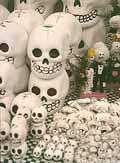
Altars in the
homes are decorated with bread, candy, fruit, and
flowers.Pictures of the deceased family members
are added. In the late afternoon special all
night burning candles are lit - it is time to
remember the departed - the old ones, their
parents and grandparents.
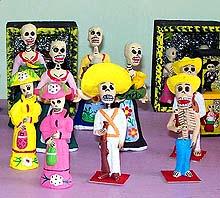
The next day
the families travel to the cemetery. They arrive
with hoes, picks and shovels. They also carry
flowers, candles, blankets, and picnic baskets.
They have come to clean the graves of their loved
ones. The grave sites are weeded and the dirt
raked smooth. The Crypts are scrubbed and swept.
Colourful flowers, bread, fruit and candles are
placed on the graves. Some bring guitars and
radios to listen to. The families will spend the
entire night in the cemeteries.
|
The people dress up as ghouls,
ghosts, mummies and skeletons. They parade a live
person in a coffin through the streets. Vendors
toss fruit, flowers and candies into the coffin.
Skeletons and skulls are found everywhere.
Chocolate skulls, marzipan coffins, and white
chocolate skeletons. Special loaves of bread are
baked, called pan de muertos, and
decorated with 'bones'.
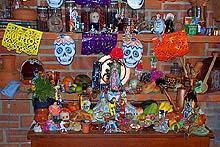
The hand crafted skeletons,
Calaveras are funny and friendly rather
than frightening or spooky. They represent the
beloved dead ones, their occupations and hobbies.
As they are placed on the altar, the delightful
skeleton figures bring back fond memories and
cause the grieving ones to smile. The figures
with the smells of favorite foods, help the
spirits find the right house.
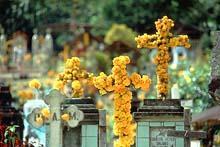
|




|




